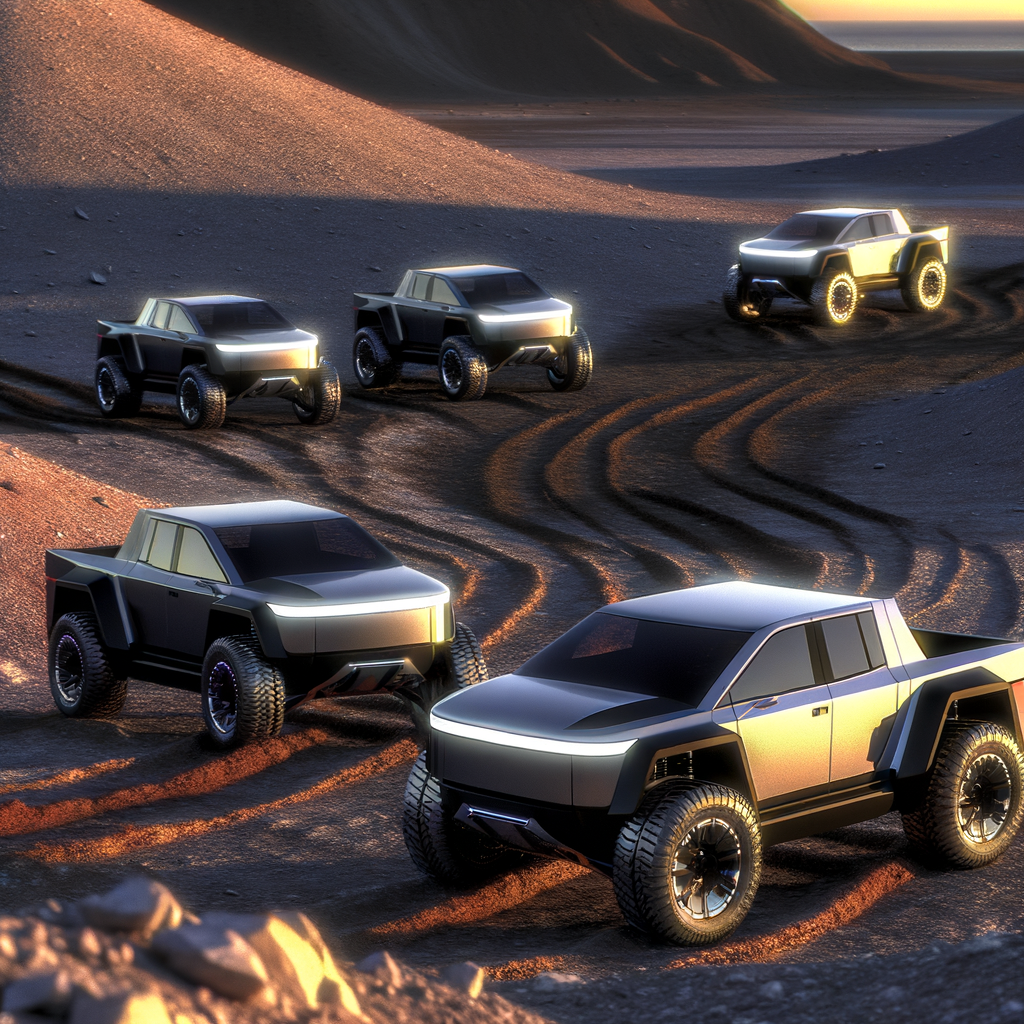Automakers & Suppliers
2025 Rivian R1T and R1S: Enhanced Efficiency, Comfort, and a New Lifeline for the Adventure-Focused Brand

Analysis: 2025 Rivian R1T and R1S Enhanced for Better Efficiency and Comfort, Offering Renewed Hope
Rivian has revamped the batteries, motors, and overall body design of its R1T and R1S models.
This year, the R1 models are being equipped with lithium-iron-phosphate (LFP) batteries for the first time.
The makeover might make the R1 models more similar to Rivian's forthcoming R2 lineup.
This week in Seattle, Rivian introduced its updated R1 series, designed to enhance the brand's adventure-driven lineup with improved efficiency and comfort.
With the Space Needle towering in the background, I took various models from Rivian's updated lineup for a test drive. It became clear that the company has significantly improved them in many aspects. At the same time, Rivian is carefully balancing the desires of current R1 and high-end EV owners, ensuring compatibility with its much-anticipated Rivian R2 series, and addressing the company's own requirements to remain a standalone American car manufacturer.
On the surface, the Rivian R1S electric SUV and the Rivian R1T electric pickup might appear quite similar to their earlier versions in terms of body shape and interior design. However, almost every component and technological feature inside these vehicles has been significantly improved. The underlying body structure has also been redesigned to facilitate easier assembly and reduce weight.
2025 Rivian R1 Series
2025 Rivian R1 Series
2025 Rivian R1 series
During a few days spent with the Rivian team in Seattle, Green Car Reports gained insight into Rivian’s methodical approach in addressing almost every issue raised by early users. They not only made targeted improvements based on customer feedback but also introduced innovative features to attract new buyers.
2025 Rivian R1T and R1S offer options of 2, 3, or 4 motors
For 2025, the R1T and R1S models will come with battery choices of Standard pack, Large pack, and Max pack, and will feature Dual-Motor, Tri-Motor, and Quad-Motor setups.
During last summer, Rivian introduced Dual-Motor models featuring their own motors, which are also utilized in the EDV. With this update, the R1 series has phased out the older Quad-Motor configuration, replacing it with two sizes of dual-motor units that include Rivian's proprietary oil-cooled motors.
These engines are manufactured for mass production, potentially aiding the company in focusing more on the smaller R2 series. Despite the variety in their configurations, the engines feature uniform windings and magnets, with inverter technology that is consistent both front and back and developed internally. Rivian's approach prioritizes front motors for fuel efficiency, while the rear motors, which can be disengaged, are geared towards enhancing performance.
Rivian reports that its new Tri-Motor models surpass the speed of the earlier Quad-Motor versions. The Quad-Motor configurations consist of two paired motors in a modular setup, with smaller motors at the front. Combined, they generate 1,025 horsepower and 1,198 lb-ft of torque when using launch control mode, allowing the vehicle to accelerate from 0 to 60 mph in under 2.5 seconds, according to Rivian. On the other hand, the Tri-Motor models produce 850 horsepower and 1,103 lb-ft from a dual-rear-motor system complemented by a single front motor, achieving a 0-60 mph time of 2.9 seconds. The Dual-Motor models are available in standard and performance variants. The standard version delivers 533 horsepower and 610 lb-ft of torque, with a 0-60 mph time of 4.5 seconds, while the performance version offers 665 horsepower and 829 lb-ft of torque, reaching 0-60 mph in 3.4 seconds.
On the exterior, the differences between these models are minimal. The Quad-Motor versions feature brake calipers in a new shade called Laguna Blue, accompanied by a subtle "QUAD" emblem on their rear badge. In contrast, the Tri-Motor models come with yellow brake calipers and a yellow strip on the rear badge.
2025 Rivian R1 series
The Rivian R1 Series for 2025
2025 Rivian R1 Series
The Tri-Motor and Quad-Motor models are designed to provide a stronger boost from the rear motors, featuring a reduction ratio of 11.7:1 at the back compared to 9.1:1 at the front. During my test drive with launch control on a Quad-Motor model at a dragstrip, I noticed that these trucks can accelerate quickly from a standstill and maintain near-maximum power for longer durations at higher speeds than previous versions.
Rivian employs a sophisticated torque distribution system that adjusts according to the selected driving mode. In the 3-motor models, dual-motor units are located at the rear, while in the 4-motor models, they are placed both at the front and rear, operating independently to drive their respective wheels. For the front wheels, the Dual-Motor and Tri-Motor models use a single motor combined with a differential and brake-torque application. Regardless of the setup, the R1 series can disconnect the motors from either the front or rear axle to optimize traction and efficiency. During gentle acceleration and most cruising scenarios, the R1 prioritizes the front wheels, shifting more power to the rear motors when greater acceleration is required.
The maximum towing capacities for the R1T and R1S remain at 11,000 pounds and 7,700 pounds, respectively.
Rivian has introduced a new battery pack design for its R1S and R1T models, focusing on reducing weight, improving manufacturability, and cutting costs. Despite these changes, the company's signature architecture, which includes a flat cooling plate placed between two layers of cells in the Large and Max Packs, remains intact. The Standard Pack now offers 92.5 kWh of usable capacity. The Large Pack comes with 109.4 kWh, and the Max Pack remains largely the same with a capacity of 141.5 kWh.
Indeed, the capacities for the Standard and Large packs are lower compared to the 2024 models. However, due to Rivian's efficiency enhancements, the ranges now start at 258 miles according to EPA standards. Even the Standard Pack variants are projected to achieve around 270 miles, matching the range provided by the 106-kWh Standard Pack for the first generation, highlighting significant efficiency gains. Although the final range ratings are still pending, Rivian anticipates the Dual-Motor R1T with the Max Pack to reach up to 420 miles of EPA range, and the Dual-Motor R1S with the Max Pack to achieve up to 410 miles. Rivian asserts that the second-generation R1T will be the most efficient truck available, and we eagerly await its performance in real-world conditions.
The lineup now features new 22-inch wheels, replacing the previous 21-inch options. These wheels are designed for aerodynamic efficiency, resulting in a drag coefficient as low as 0.297 and enhancing the vehicle's range.
Rivian R1 thermal management system
Rivian R1 thermal management system
Rivian's engine technologies
The heat pump has finally arrived, enhancing the entire R1 series. This new addition boosts actual driving range by an average of up to 10 miles, with even greater improvements under certain conditions. By incorporating the heat pump, Rivian has eliminated the need for a traditional resistive heater, choosing instead a component that heats the coolant as required, maintaining system efficiency.
Moreover, taking into account all these enhancements in efficiency and production, it's reported that the carbon footprint of the R1 has been reduced by 15%.
The Large Pack and Max Pack options continue to use 2170-format cylindrical cells with nickel cobalt aluminum (NCA) chemistry, now with an approximate 6% increase in energy density. Meanwhile, the new LFP cells employ large-format pouch cells that are stacked at the same height as the two layers of cylindrical cells, but with a completely different internal cooling method. According to officials speaking to Green Car Reports, the energy density of these LFP cells is just slightly lower than that of the NCA cells. Rivian has not disclosed the supplier of these LFP cells yet.
Rivian's LFP Battery Pack
Second Generation Battery Pack by Rivian
First-generation Rivian battery pack
Rivian has introduced a new battery-pack design that builds on its earlier version, reducing both weight and complexity. The battery case is now made using high-pressure die-casting instead of extrusion, which increases precision and results in a 55-pound weight reduction. Overall, the entire battery pack assembly is 154 pounds lighter, thanks in part to a unified unit that integrates the battery management system.
No 800V—so no major charging upgrade
Contrary to previous hints from Rivian, the Gen 2 models do not feature an 800-volt architecture. Years ago, CEO RJ Scaringe had indicated that this upgrade might come with the first major update to these vehicles. Although Rivian has suggested that the R1 series could support bidirectional charging, company representatives have not provided specific details on the timing or method of this feature's rollout.
In terms of charging capabilities, there haven't been significant changes. Rivian has managed to make the charging curve more consistent and prolonged. However, the maximum charging power is still 220 kW for the Large and Max battery packs, while the Standard Pack, which uses LFP cells, peaks at 200 kW. According to Rivian, a rapid charge from 10% to 80% will take between 30 and 41 minutes, depending on the battery type. The vehicles can gain approximately 140 miles of range within about 20 minutes of charging. Meanwhile, Level 2 charging remains capped at 48 amps (11.5 kW), which may not be sufficient to fully charge a Max Pack battery overnight.
Significant efforts have been made to modernize and streamline the R1’s electrical system, addressing concerns such as "vampire drain," enhancing efficiency, and simplifying the supply chain. The design overhaul features a more straightforward configuration, reducing the number of ECUs from 17 to 7 and eliminating 1.6 miles of wiring from the vehicle. Additionally, a new mini DC-DC converter has been introduced to maintain the 12-volt battery at a nearly constant charge, powering accessories like infotainment systems and lights.
People who enjoy outdoor activities rely on their vehicle maintaining the same level of battery charge they had before their trip. Rivian now asserts that their vehicles have the lowest range loss in the industry, as long as the Gear Guard system, which uses cameras and processing units, is turned off.
Rivian R1T 2025
Rivian R1 Series for 2025
2025 Range of Rivian R1 Models
R1 lighting collaborates with you
Rivian has retained the vehicle’s original design and its distinctive lightning signature. In fact, they’ve enhanced this unique feature with innovative active-matrix headlamps that incorporate adaptive-beam technology, which Rivian plans to activate later this year. Initially, the lighting will include adaptive cornering capabilities, and the adaptive high beam function is currently in the final stages of certification, to be activated through a future software update.
In addition to the updated headlights, the front lightbar is now proving to be quite functional. It consists of 10 separate RGB light segments capable of displaying virtually any color. One of its first practical applications is to indicate the battery charge level in percentage at a quick glance. According to Jeff Hammoud, Rivian's chief design officer, the combination of these headlights and the RGB lightbar offers numerous possibilities for hidden features or "Easter Eggs."
According to Hammoud, these modifications bring significantly greater depth to the overall lighting design. "It continues to be unmistakably Rivian; we adore the front-end look," he commented. "Creating something that is straightforward, easy to characterize, and iconic is quite challenging, and we are pleased to have achieved that, so we have no intention of moving away from it."
The glass roof of the R1 series is also a new feature, offering adjustable tinting and a customizable multi-color lighting system inside.
Rivian has simplified its user interface to make it easier to navigate. To enhance the visual elements, the company collaborated with Epic Games, utilizing its Unreal Engine. Despite the impressive graphics, the interface remains one of the most user-friendly options available, particularly for monitoring various vehicle systems.
In addition to the user interface, notable features observed by this reporter include the new electronic door releases operated by buttons (a luxury feature, though manual pulls are still available and functional), as well as updated interior upholstery and surfaces, which now feature a plaid-quilted design for the seats and mats.
2025 Rivian R1S Model
Model Year 2025 Rivian R1S
The 2025 Rivian R1S
Updated Rivian R1 driving experience: Enhanced luxury
The interior of the R1 series now exudes a greater sense of luxury, and this improvement is more about the driving and handling dynamics than the addition of new features.
At that stage, once the Gen 2 is in motion—even on urban roads—it immediately grabs your attention. Rivian has successfully eliminated the harsh, occasionally loud ride of previous models by introducing a gentler suspension setup across the range. This change doesn’t compromise handling and might even enhance it under challenging conditions.
To achieve this, the front spring rate was heightened, while the rear spring rate was reduced. Additionally, a new damper calibration and new bushings were implemented. Every model continues to use air springs, but the adjustments are intended to optimize performance with the vehicles' rear-focused weight distribution and power output.
The suspension system integrates seamlessly with the added Rally and Drift modes available in the Tri-Motor models. Testing the R1S on a muddy off-road track designed to evaluate its dynamics, I noticed a significant distinction between the two modes, primarily due to variations in the hydraulic roll control.
I also tested the R1T on a rugged off-road trail, which highlighted the vehicle's impressive wheel articulation and overall capability on difficult terrain. The R1T has a maximum ground clearance of 14.6 inches, while the R1S boasts 14.7 inches. At the deepest water crossing, the light bar on our R1T was just touching the water. The R1 trucks can handle water depths of up to 43 inches, so despite the heavy rain and deep water, we were far from reaching the vehicle's limit.
2025 Rivian R1 series
Rivian R1's connectivity and sensory features have seen a significant upgrade. The new Rivian Autonomy Platform integrates 11 cameras, five radar units, and advanced AI algorithms to offer 350-degree visibility. This setup boasts eight times the camera resolution of previous models, significantly enhancing vision in poor weather and low-light conditions. The basic version of this system includes blind-spot monitoring and driving aids such as active lane control and adaptive cruise control. A more advanced "plus" version will initially offer driver-initiated lane changes and will soon include an even more sophisticated system, the details of which are forthcoming.
Rivian has introduced a new high-end audio system featuring Dolby Atmos, which will initially include Apple Music and its Spatial Audio capabilities. For $14.99 per month, Rivian Connect+ provides access to Apple Music, wifi hotspot features, and additional services. Moreover, apps compatible with Google Cast can now stream video and audio entertainment on the vehicle's display screen, a useful feature during charging breaks. However, it's important to note that Apple CarPlay and Android Auto are not supported for integrating your smartphone with the vehicle.
Rivian owners have the ability to unlock their vehicle using Apple Wallet on their iPhone or Apple Watch, as well as certain Google Pixel devices. They can also share access with family or friends, or provide temporary access equivalent to a day pass.
2025 Series of Rivian R1 Vehicles
Starting this Friday, June 7, deliveries for the second-generation R1 lineup will commence. The 2025 Rivian R1T will be priced at $71,700, which includes an $1,800 destination fee, and the 2025 Rivian R1S will start at $77,700. At the higher end, the Tri-Motor Max Pack versions will cost $101,700 for the R1T model and $107,700 for the R1S model. Prices for the Quad-Motor Max Pack models have yet to be announced and will be available at a later date. Rivian is offering these vehicles in two trims: Adventure and Ascend. Specific feature differences between these trims have not yet been detailed. The Dual-Motor and Performance Dual-Motor variants will be available exclusively in the Adventure trim, while the Tri-Motor and Quad-Motor versions will be available only in the Ascend trim.
In the meantime, Rivian is in the last phases of developing its R2 series, which is crucial for the company's future. The R2 is expected to incorporate the motor systems from the R1 and other features, while also advancing significantly in terms of affordability for the general market, profitability, and the long-term sustainability of the company. From my observations and the potential enhancements it can bring to the R1 series, there is considerable optimism that Rivian will succeed in these endeavors.
Rivian arranged lodging in Seattle and supplied nutritious meals to support the process of this review.
Labels:
Add Content:
Process Explained:
Readers interested in this content also checked out:
Spread the Word:
Reach out to the editor:
Stay Updated:
Green Car Reports Email Updates
Subscribe for the most recent news on green cars and environmental topics, sent to your email every day!
I consent to getting emails from Green Car Reports. I know I can opt out whenever I choose. See Privacy Policy for more details.
Take a look at the initial experiences with the Rivian R1S and R1T, as well as the Toyota Crown Signia hybrid wagon. Recent survey data reveals that a growing number of Americans are hesitating on electric vehicle purchases due to concerns over charging infrastructure. Additionally, it turns out that large, fuel-inefficient SUVs do not necessarily offer better safety. This and more, reported by Green Car Reports. According to a new series of crash tests conducted by the Insurance Institute for Highway Safety (IIHS), several prominent, fuel-thirsty SUVs like the Chevrolet Tahoe, Ford Expedition, and Jeep Wagoneer do not hold up well in terms of safety. Among these three-row SUVs, which generally achieve less than 20 miles per gallon, only the Wagoneer earned the highest safety rating.
According to the AAA, consumer interest in electric vehicles has decreased in 2024 compared to 2023, with factors such as expenses and charging availability contributing to this decline.
The Ford Expedition and Chevy Tahoe are often chosen for their reputed safety, but recent evaluations reveal that these fuel-intensive vehicles fall short in that regard.
A new electric crossover is set to debut alongside the Polestar 3 in just a few months.
The Senator contends that relaxing regulations to permit automakers to utilize electric vehicle battery materials from China for an extended duration would constitute a violation of the law.
Toyota has broadened its U.S. Crown series by introducing a more family-friendly vehicle that mimics the appearance of a crossover.
In the 1890s, New York introduced electric taxis, reflecting an era of automotive experimentation where electric vehicles vied with both gasoline-powered and steam-driven cars.
A leading battery provider in Europe reports that car manufacturers are requesting cheaper batteries, which is causing uncertainty about current plans.
Numerous electric vehicles from Mercedes have been recalled. Ford might be considering an innovative approach to battery swapping. Plus, what’s causing the delays in the federal EV charging network rollout? These stories and more are covered today at Green Car Reports. Mercedes-Benz is recalling almost 15,000 EVs due to a software problem that could result in…
The car manufacturer has explored techniques for exchanging batteries that utilize the vehicle’s own energy to finish the process.
Although the federal government allocates the funds, it is the states that decide on the specifics of their usage and timing.
Related Stories
Top Picks
Images
Updates
Press
RSS Feeds
Organization
Stay Connected with Us:
Discover more from Automobilnews News - The first AI News Portal world wide
Subscribe to get the latest posts sent to your email.






















































